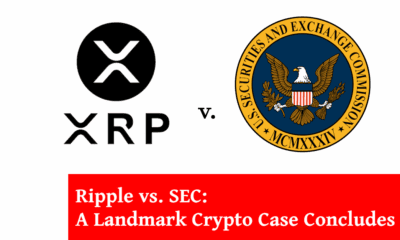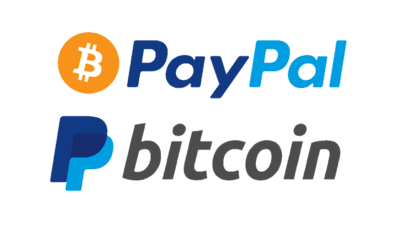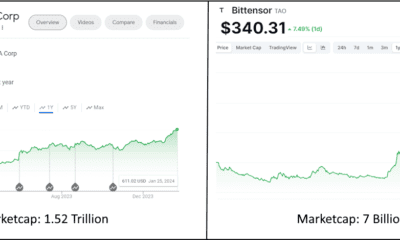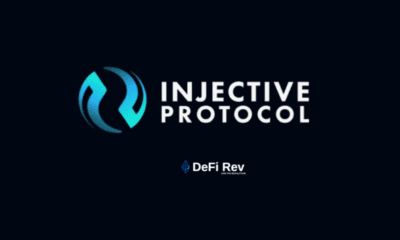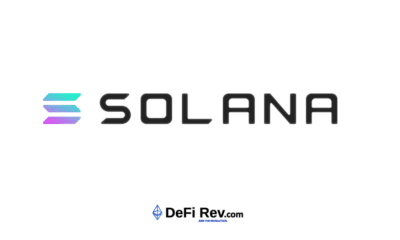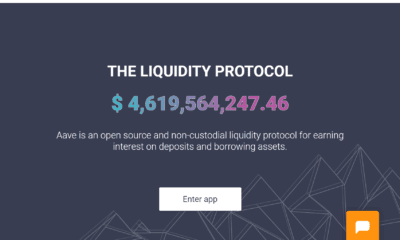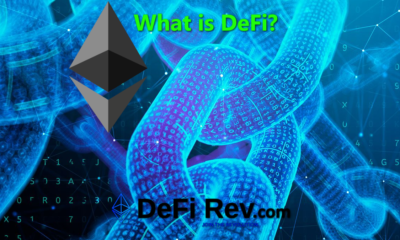trading
Ripple price rally is impressive, but can it last?

Unraveling XRP’s rise and conquering the crypto markets
Ripple (XRP) has one of the most popular tokens for quite some time in the crypto martkets. For years now XRP has been sharing space with Bitcoin and Ethereum ranking third in terms of market value. In the last one month, XRP price has rallied by about 91% and there are factors which have attributed to its break above the present multi-year range.
In the past one month, the price of XRP has rallied 91% as it has suddenly found some sheen owing to external factors. It is now fast catching up with Bitcoin (BTC) and Ether (ETH). The catalysts for the growth are likely to be several factors for the XRP rally are the rise in unique addresses, buybacks from Ripple, a new product release, the US Central Bank’s decision to digitize currencies, and of course the landmark pandemic-era US elections. Let’s analyze why Ripple is emerging so strong.

Source: TradingView
Increase in Unique addresses
If one has to understand the overall sentiment around the cryptocurrency, then on-chain data comes in handy because it genuinely depicts and reflects the activities that take place on the blockchain. Taking this idea along, in the case of XRP, addresses that are interacting with XRP have spiked in late November and the trend has only intensified when the cryptocurrency rose a massive 27% in one day on November 22.

Source: Santiment
Santiment, an on-chain analysis firm has implied that the single-day increase in active addresses was observed to be the largest since May 1. They further said:
“Ripple’s price skyrocketed +27% today, and the number of unique addresses transacting on the $XRP network in a single day (24,408) was the highest output since May 1st.”
Price rise and increase in Active addresses happen in tandem for many reasons. The number of addresses that accumulate XRP can possibly and potentially also increase its value spikes. Combined with this, there can be a general rise in user activity on the blockchain.
Central Bank’s talk of digital currencies
As per a recent job posting by Ripple, the firm is looking for a senior director of Central bank engagements who will actively focus on supporting CBDC initiatives with Ripple’s real-time gross settlement system, XRP ledger. So based on this, we understand that Ripple is bracing itself to define its CBDC strategy with Central banks much ahead of the action. It is building relationships, projects and educating global central bankers above the new move and there is a lot of hope and positivity surrounding this.
This reaffirms that Ripple is keen on implementing its technology for developing CBDCs. Ripple in fact is an important tool that enables interoperability between global CBDCinitiatives. Way back in August, Emi Yoshikawa, senior director of global operations at Ripple claimed that XRP will not compete but complement CBDCs.
It is unclear whether Ripple is involved with the CBDC pilots to date but the organization is in touch with many global central banks. In May 2020, as per some reliable reports, Ripple also had a closed-door meeting with the Central Bank of Brazil to discuss this. Ripple is looking way forward and has become more future-oriented and this could be a likely reason for the newly-generated interest.
Ripple Buybacks
In the third quarter of 2020, Ripple apparently bought $45.5 million worth of XRP in a repurchase program. The company explained that the move was necessary to support the trend for healthy markets. The purchases totally $45.5 million was made and the sales summary listed read:
“As indicated in the Q2 2020 XRP Markets Report, Ripple is purchasing — and may continue to purchase — XRP to support healthy markets.”
A buyback can also cause a rise in the value of the asset because it generates interest in it. Although in terms of what it stands for today, the value of buyback may not be substantial it is good enough to rouse positive sentiments in the market.
Launch of Paystring
Ripple Labs filed a trademark in early November, for a product called Paystring with the US parent and Trademark office. The application stated:
“PAYSTRING trademark registration is intended to cover the categories of electronic financial services, namely, monetary services for receiving and disbursing remittances and monetary gifts in fiat currencies and virtual currencies over a computer network and for exchanging fiat currencies and virtual currencies over a computer network.”
trading
Pump.fun coin founders raise $1.32 billion

Pump.fun coin founders rake in billions
Pump.fun’s latest growth streak began with the conclusion of its public sale on July 12th, which brought in $1.32 billion across private and public rounds. The public portion alone, priced at $0.004 per token, raised $600 million in just 12 minutes. This was followed by the launch of $PUMP trading, with tokens distributed and markets opening within days, making it one of the largest crypto fundraises in recent years.
Following this, the team introduced a creator-fee redirection feature for projects hosted on PumpSwap or still within the bonding curve. This update allowed fees to be reassigned to active community leads in cases of leadership changes, provided there was a clear and verified request.
Pump.fun has also rolled out a public revenue dashboard, giving the community full visibility into daily platform earnings. Over a six-day period, the team bought back 8,740 SOL worth of $PUMP, exceeding the revenue generated during that time. In their words, it was about “putting our money where our mouth is” when it comes to reinvesting in the ecosystem.
Most recently, Pump.fun launched the Glass Full Foundation (GFF), a funding program for standout communities within its ecosystem, which are often called “diehard cults” internally. As part of this launch, the team has already awarded initial grants, with more recipients expected as the program scales.
From record-breaking fundraising to ecosystem reinvestment and targeted community funding, Pump.fun has spent the past several weeks strengthening its position as a leading Solana-based memecoin launchpad.
Go back to DeFiRev.com HOME
Go to Market Watch
trading
Bittensor booms as Chip Mania hits Stock Market: The AI Race and the Potential of TAO
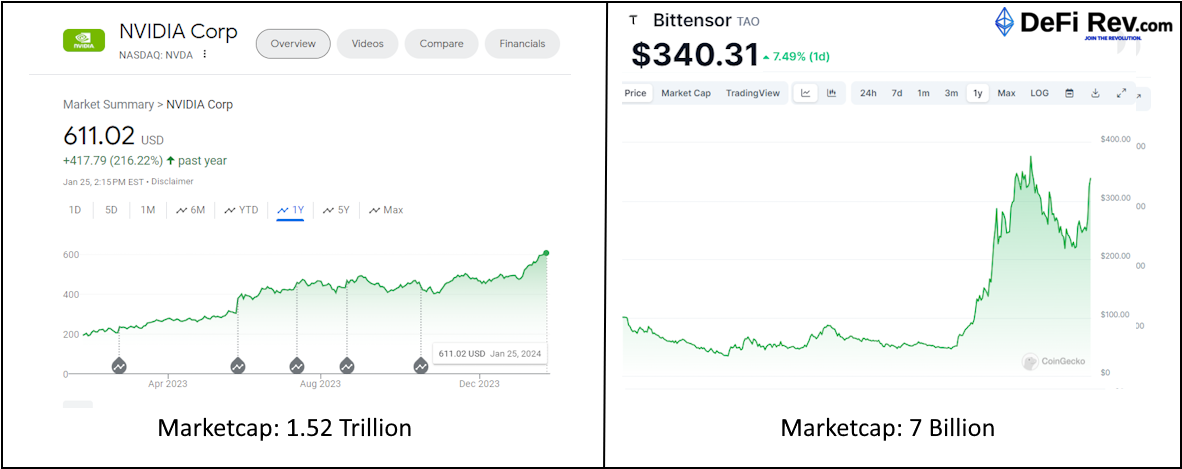
The stock market has been abuzz with the latest trend in technology investments: semiconductor chips. This “chip mania” is fueled by the global race for artificial intelligence (AI) supremacy, as chips are the fundamental building blocks of AI and machine learning technologies. As companies and countries vie for the lead in AI, the demand for advanced semiconductor chips has skyrocketed, leading to significant interest from investors. In this context, Bittensor, with its unique decentralized approach to AI, emerges as a potentially strategic investment.
Nvidia and Bittensor might seem quite different at first glance—one is a big name in computer graphics, and the other is part of the exciting world of decentralized networks. But they actually have a lot in common, especially when it comes to artificial intelligence .
The AI Race and Chip Demand
AI has become a critical component of modern technology, from consumer applications like voice assistants to complex systems such as autonomous vehicles and smart cities. The performance of AI systems is heavily dependent on the processing power provided by semiconductor chips. As AI models become more sophisticated, they require more computational resources, driving the demand for high-performance chips.
This demand has led to a surge in investments in chip manufacturers and designers. Companies like NVIDIA, AMD, and Intel have seen their stock prices soar as they continue to push the boundaries of chip performance. The market has also witnessed the rise of specialized AI chip startups, all competing to create the most efficient and powerful processors.

Supply Chain Challenges and Investment Opportunities
The increased demand for chips has not been without its challenges. The global semiconductor supply chain has been under strain, with issues such as the COVID-19 pandemic, trade tensions, and production bottlenecks leading to shortages. These shortages have highlighted the critical nature of chips in the global economy and have spurred further investment as companies seek to secure their supply chains.
Investors are keenly aware of the strategic importance of semiconductors and are looking for opportunities to capitalize on the chip mania. This has led to a bullish outlook on chip stocks, with many analysts predicting continued growth as the AI race heats up. This also has led to a boon from smart money to look into Bittensor.
Bittensor: A Decentralized Approach to AI
Nvidia and Bittensor might seem quite different at first glance—one is a big name in computer graphics, and the other is part of the exciting world of decentralized networks. But they actually have a lot in common, especially when it comes to artificial intelligence (AI). Let’s break down how they’re both helping to push technology forward:
Nvidia makes the powerful graphics cards that a lot of AI programs need to run. Bittensor, on the other hand, gives people a place to run AI programs on a network that’s spread out across many computers. Nvidia is always coming up with new ideas for its graphics technology, which is super important for video games, AI, and big calculations. Bittensor is also all about new ideas, but it’s focused on making AI services that don’t rely on just one place or computer.
Nvidia has a huge group of developers who use its tech to create all sorts of things, and it helps them out with special software and tools. Bittensor also depends on a community, but it’s made up of developers and people who contribute computer power to the network, and they get rewarded with digital tokens.
Both Nvidia and Bittensor have lots of room to grow, but in different ways. Nvidia is growing because more and more industries need its graphics cards. Bittensor’s growth is tied to how many people start using decentralized AI services and how the whole area of digital currencies and blockchain technology gets bigger.
Now, let’s imagine it’s two years from now, and Bittensor has really taken off. Here’s what that could look like:
Everyone’s Using Decentralized AI
Bittensor’s network is the go-to place for AI services that aren’t tied to one spot. There’s a big group of smart people and companies using and adding to the network.
Even small companies or solo developers can make cool AI stuff because Bittensor makes it easy to get to machine learning tools and computer power.

Amidst the frenzy for traditional chip stocks, Bittensor presents a novel investment opportunity. Bittensor is not a chip manufacturer; rather, it is a decentralized network that leverages the collective power of distributed machine-learning models. By pooling together the resources of miners across the globe, Bittensor facilitates the creation and operation of AI models in a decentralized manner.
The Bittensor network offers several advantages to Nvidia that could make it an attractive investment:
The Bittensor network offers several advantages that could make it a competitor to Nvidia.
Decentralization: Unlike centralized AI services, Bittensor is not reliant on a single entity or data center. This reduces the risk of outages and censorship, potentially leading to a more robust and resilient AI network.
Incentivization
Miners on the Bittensor network are rewarded for contributing computational resources and for the performance of their AI models. This creates a marketplace for AI services where competition drives innovation and efficiency.
Scalability
As the demand for AI grows, Bittensor’s decentralized model allows for easy scaling by simply adding more miners to the network. This contrasts with the physical limitations and capital expenditures required to scale traditional data centers.
Accessibility
Bittensor democratizes access to AI by allowing anyone with computational resources to participate as a miner. This could lead to a more diverse and widespread development of AI applications.
The chip mania in the stock market is a reflection of the critical role that semiconductors play in the burgeoning AI industry. While traditional chip stocks are an obvious choice for investors looking to capitalize on this trend, Bittensor offers a unique angle. Its decentralized network aligns with the principles of blockchain and the growing interest in distributed systems.
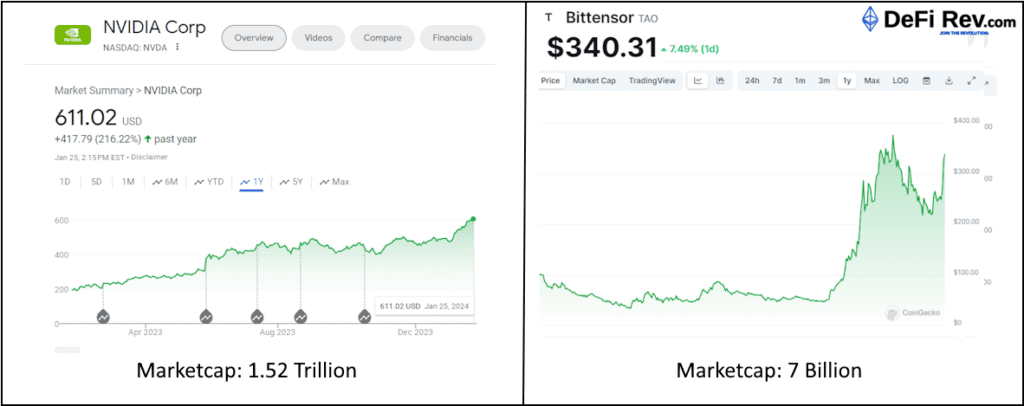
trading
AAVE CRYPTO ASSET SOARING
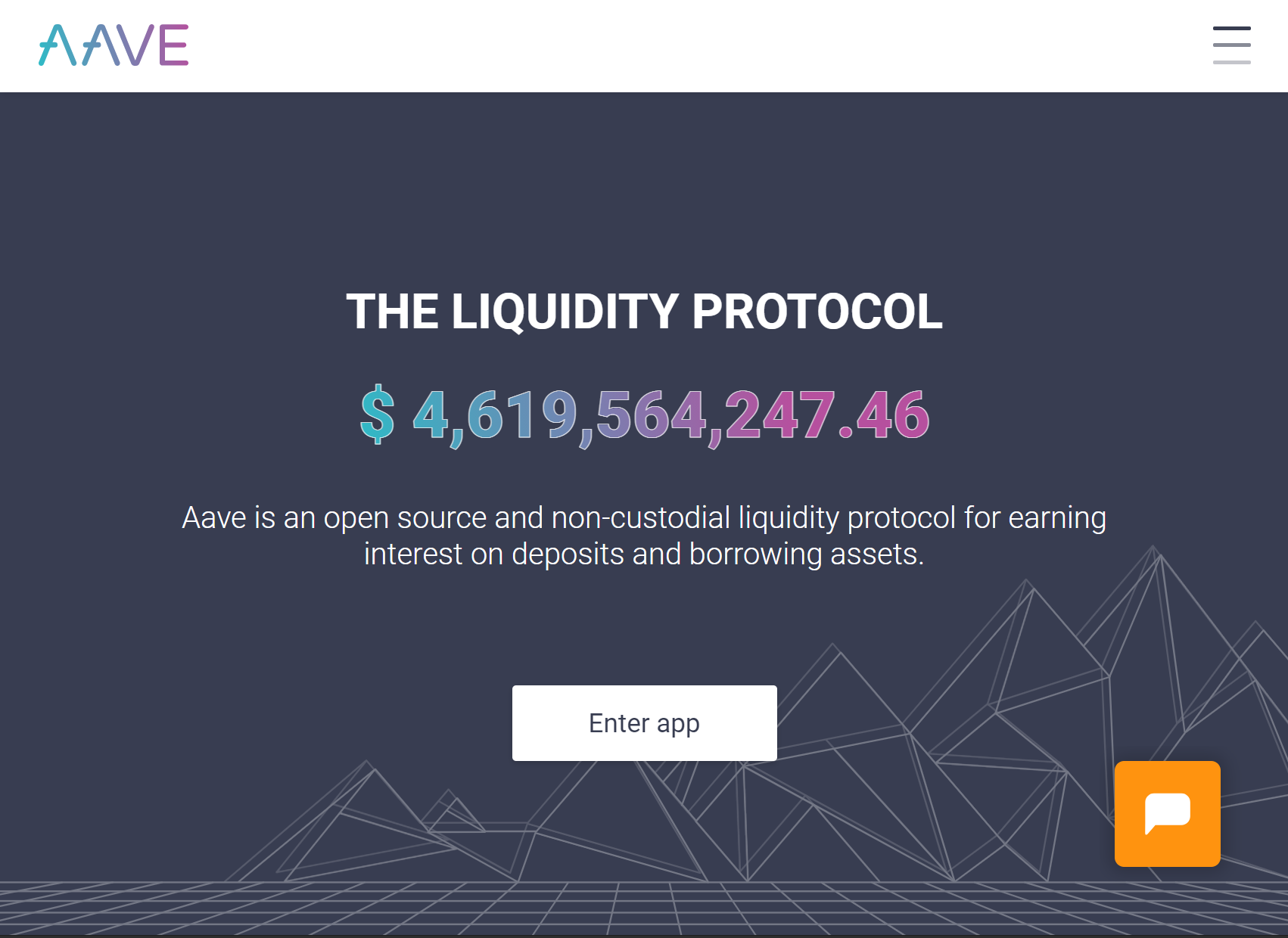

AAVE SOARING TO NEW HEIGHTS AS IT BREAKS $500 USD
AAVE is on fire reaching new all-time highs in rapid succession. As of today, February 4th, 2021, an earth-shattering volume of nearly 3 billion dollars of AAVE was traded in the past 24 hours.
Aave clocks in a new ATH ever since the v2 migration tool launch
Aave (AAVE) has been going strong ever since February began. In just 5 days, AAVE has increased by 76% and today the token hit a new all-time high of $520. The protocol to date has successfully captured users and has done well against its competition. The latest rally for Aave started on Jan 28 when the protocol announced the v2 migration tool. The tool allowed users to easily migrate all account information including the borrowed positions and staked tokens.
The new tool also facilitates easy migration of user information to the updated protocol. Recently on the 1’st of February, the team from Aave protocol posted an update about the same:
“Today is the last day to vote on the AIP to add $BAL on Aave V2.”
A day following the announcement the proposal was passed by the community. The Balancer (BAL) was added on Aave 2 and it was around that time that AAVE rallied from $284 to $300.
The DeFi platform of AAVE is also rejoicing since the platform is undergoing immense upgrades. As per DeFi pulse, the total value locked in the DeFi protocol is now at $4.96 billion ranked second after Maker which has $5.16 billion in total value locked.
AAVE, which is the 15th largest coin in terms of market cap, also recorded a staggering 24-hour trading period. Its trading volume in the last 24-hours touched $2.4 billion! Treyce Dahlem who is a research analyst believes that the recent surge in AAVE price has been fuelled by the big players and institutions who are becoming increasingly interested in DeFi.
He added, “Billionaire Mark Cuban recently spoke about the “unlimited upside” of DeFi and according to a snapshot of his on-chain portfolio, he is an AAVE whale holding more than $150,000 worth of the token. Grayscale recently filed more than a dozen altcoin trusts with Delaware’s corporate registry, one of those altcoins being AAVE. Additionally, Bitwise added AAVE to their Bitwise 10 Large Cap Crypto Index. These announcements have caused investor sentiment to reach a new YTD high of 83.5 (very high).”

AAVE is quickly becoming a household name in DeFi for its revolutionary approach to decentralized lending, and our analysts believe that with the stellar leadership of Stani Kulechov, the Founder and CEO of AAVE, we predict AAVE will move into the top 10 digital assets quite quickly.
It seems apparent that AAVE is the de facto industry leader in its sector, and we surmise that it will be the perfect way for the everyday individual to get their feet wet with DeFi.
Recently, the migration tool from V1 to V2 was made available.
-

 news2 years ago
news2 years agoPayPal Crypto Bound! PayPal is betting on bitcoin and DeFi in a BIG way.
-

 trading2 years ago
trading2 years agoBittensor booms as Chip Mania hits Stock Market: The AI Race and the Potential of TAO
-

 trading2 years ago
trading2 years agoInjective Protocol, the new Binance IEO, packs a punch
-

 trading2 years ago
trading2 years agoUniSwap Heating up BIG TIME! Is this the end of IEOs? New DeFi Projects fundraising on Uniswap.
-

 interviews2 years ago
interviews2 years agoBobby Ong CoinGecko CEO: Interview with the Trailblazing Entrepreneur
-

 trading5 years ago
trading5 years agoWhat is Solana? How SOL is aiming to solve scaling issues.
-

 trading2 years ago
trading2 years agoAAVE CRYPTO ASSET SOARING
-

 news2 years ago
news2 years agoDecentralized Finance explained. What is DeFi?

